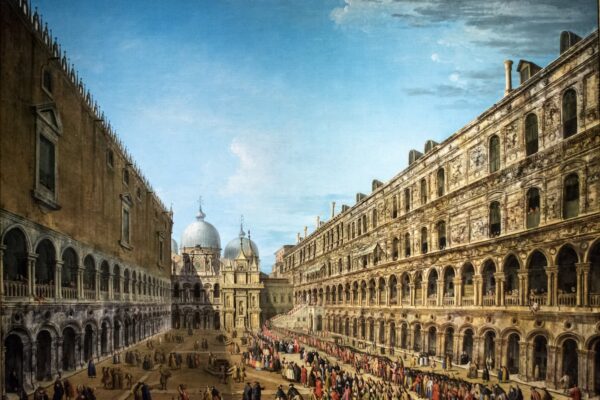The Doge’s Palace in Venice is the second most visited attraction in Venice after St Mark’s Basilica, and one of the most famous in the world. Besides the most famous works of art, the 2 million visitors have so much more to discover about this unique enchanting place.
Here are the secrets and curiosities of the Doge’s Palace in Venice.

Doge’s Palace Venice skip-the-line ticket: quick access
Buy online. Choose your preferred time. Visit Venice’s Doge’s Palace, Bridge of Sighs, prisons and more.
You can cancel for free up to the day before your visit.
Table of content
- 1 Facts and curiosities about the Doge’s Palace in Venice
- 1.1 It was devastated by several fires (and then rebuilt)
- 1.2 There is a room called the Torment Room
- 1.3 The Doge lived in a rather small room
- 1.4 It has many ‘imitations’ around the world
- 1.5 The legend of the Bridge of Sighs in Venice
- 1.6 The Hall of the Great Council is immense
- 1.7 In the Hall of the Great Council there is a painting of a traitor
- 1.8 There was a blind Doge
- 1.9 It was built to be a fortress (and not a palace)
- 1.10 Each high relief on columns and capitals tells a story
- 1.11 Casanova managed to escape from the prisons of the Doge’s Palace
- 1.12 The Doge’s Palace was reproduced in the video game Assassin’s Creed II
- 2 Conclusions
Facts and curiosities about the Doge’s Palace in Venice
It was devastated by several fires (and then rebuilt)
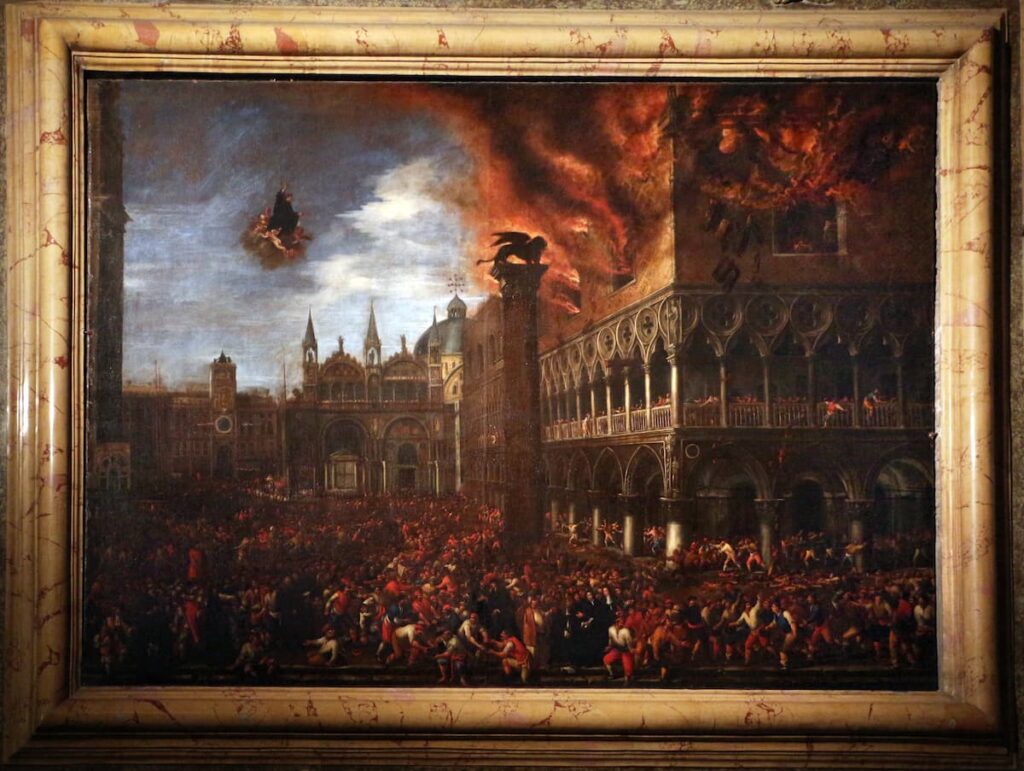
In 1483, a devastating fire swept through the canal side of the palace, including the Doge’s flats. At this time, Antonio Rizzo introduced elements of the new Renaissance style into the building. The restoration and reconstruction work was completed in 1510, when Pietro Lombardo took Rizzo’s place. This new architect initiated the design of the façade and the construction of the Giant’s Staircase in the inner courtyard.
In those same years, Jacopo Sansovino created two imposing marble statues depicting Mars and Neptune, placed at the top of the Giant’s Staircase. In 1574, another fire broke out, causing damage mainly to the wooden furnishings, without inflicting serious structural damage.
However, the year 1577 brought with it another disaster: a destructive fire hit the Scrutiny Hall and the Hall of Great Council, causing the loss of artistic masterpieces by masters such as Gentile da Fabriano, Pisanello, Alvise Vivarini, Carpaccio, Bellini, Pordenone and Titian.
Despite the adversities, in 1580 it was possible to restore the area to its original characteristics, thus preserving the integrity and intrinsic beauty of the Doge’s Palace.
There is a room called the Torment Room
The Torment Room, a place that inspired fear in the hearts of the accused, represented an atmosphere of terror and oppression.
Before their turn for interrogation, the prisoners were forced to wait in total darkness. As they were plunged into darkness, the roar of painful screams echoed through the air, even though those screams were actually simulated by paid actors, a trick designed to amplify the anguish that was inhaled.
It was in this cramped environment that interrogations took place. During these sessions, the criminals were subjected to an extremely painful procedure: tied behind their backs, they were pulled by the arms using a rope. This unnaturally contorted position conveyed feelings of intense torment and suffering. The aim of this torture was to obtain a confession regarding the alleged crime committed by the prisoner.
The practice of torture continued relentlessly until the prisoner succumbed to the pressure, confessing to the crime to end the unbearable pain.
This obscure glimpse into the history of the Doge’s Palace bears witness to the cruel methods used in interrogation and the justice system of the time, offering a poignant picture of the hardships faced by prisoners at the time.
The Torment Chamber can be visited during the Secret Itineraries Tour of the Doge’s Palace in Venice.
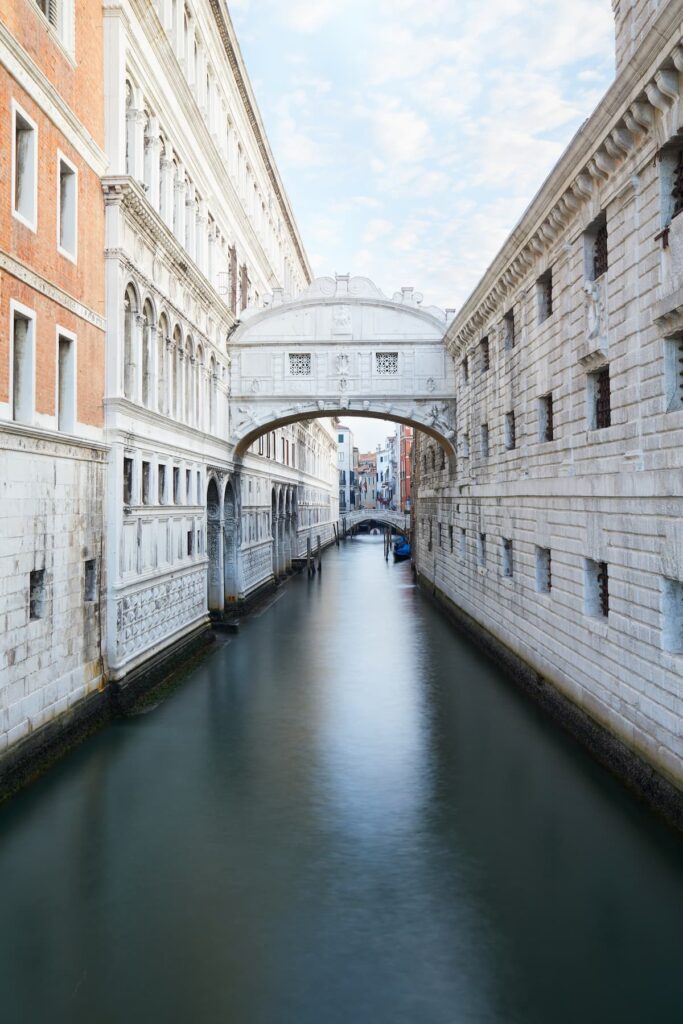
Secret Itineraries of the Doge’s Palace Venice: tickets for the guided tour
Join the behind-the-scenes tour of the Doge’s Palace Venice and discover the Doge’s best-kept secrets. See the secret archives, offices, torture chambers, palace attic, and maximum security prison cells.
The Doge lived in a rather small room
Until the 17th century, the rooms intended for the Doge’s residence were characterized by their relatively small size, often smaller than those the Doge was used to in his private life.
This choice was intentional, aimed at downplaying the ‘grandeur’ of the Doge and emphasizing the primacy of the Venetian Republic over his individual role.
The rooms were designed to convey the message that the Doge should primarily serve the Republic of Venice, putting the collective good above his personal needs. This architectural arrangement was a constant reminder of his duty of leadership and responsibility to the state.
When a new Doge took office, it was customary for him to bring his furniture and personal items with him from his private residence. These personal items defined his private dimension within an institutional setting.
Upon the death of the Doge, such furnishings were removed by his closest relatives, paving the way for his successor to take his personal items with him and create a bespoke environment for his reign.
This practice not only emphasized the importance of individuality within a collective political context, but also the continuous transition of leadership within the institution of the Doge and the perpetuation of the Venetian Republic through the centuries.
It has many ‘imitations’ around the world
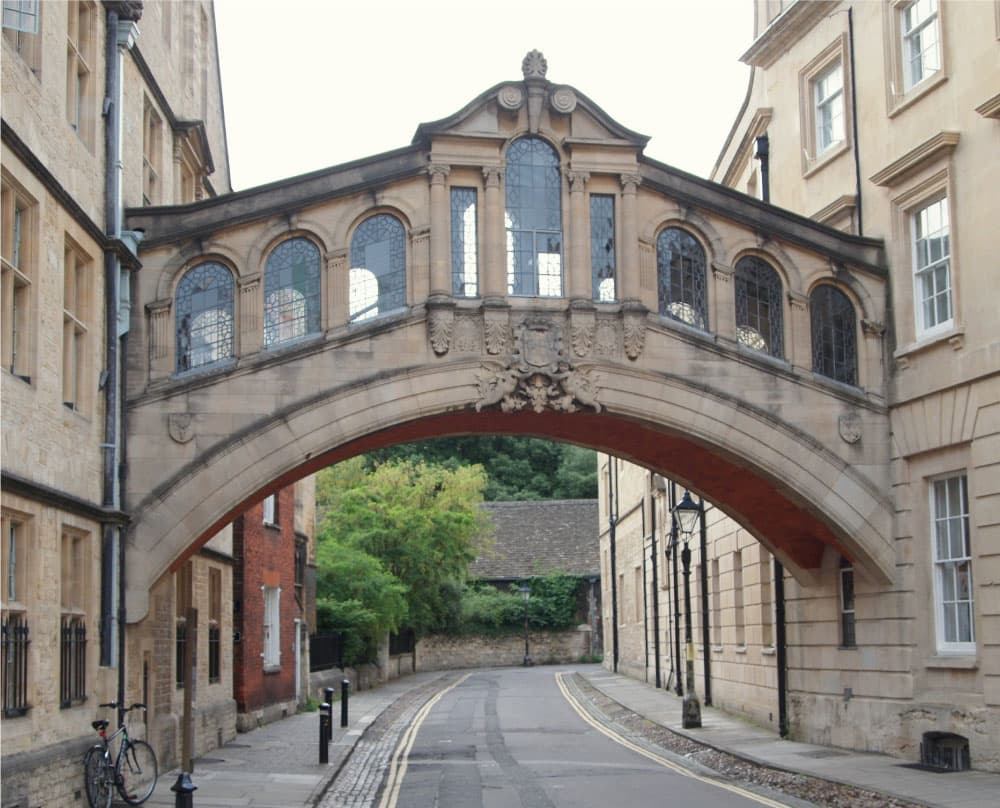
There are numerous buildings that have attempted to emulate the architectural style of the Doge’s Palace, especially in the United Kingdom. Notable examples include the Wedgwood Institute in Burslem, Templeton’s Carpet Factory in Glasgow, the Wool Exchange in Bradford and the Scottish National Portrait Gallery in Edinburgh.
Inspired by the aesthetics and elegance of Venetian architecture, these buildings sought to capture the essence of the Doge’s Palace and its cultural and historical significance. Through architectural details and decorative motifs, they created a reflection of the majestic Venetian palace in different geographical and cultural contexts.
Even the world-famous Bridge of Sighs has been imitated: we find two imitation examples in Cambridge and Oxford, UK, and one in Lima, Peru.
The legend of the Bridge of Sighs in Venice
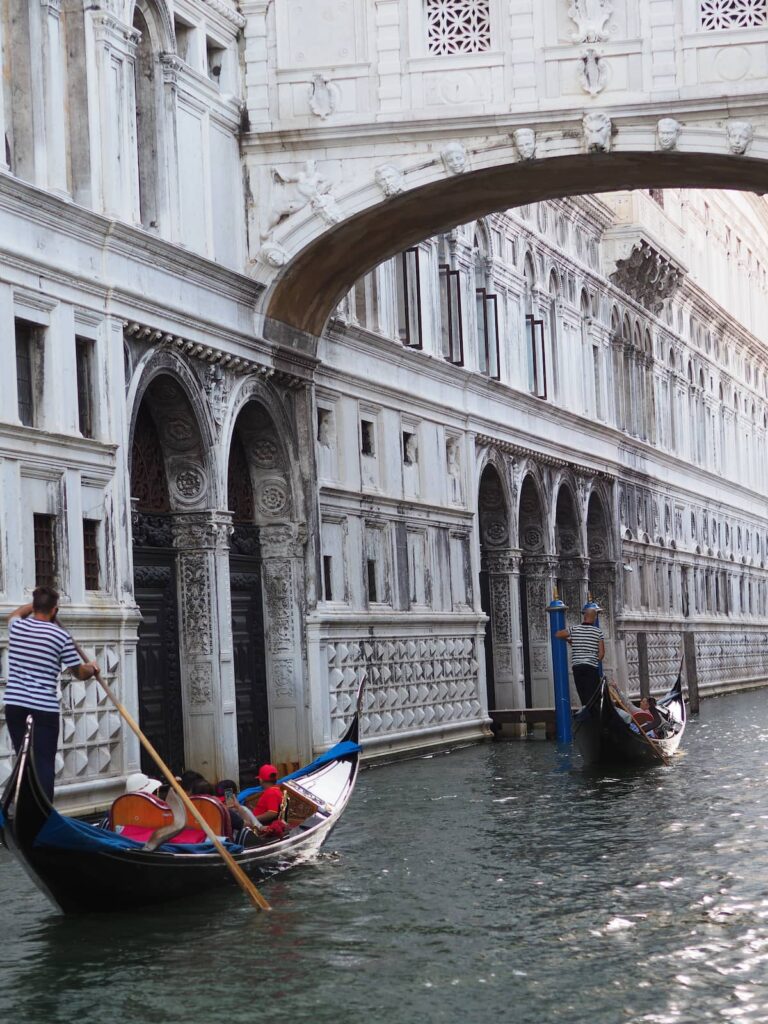
Although the Bridge of Sighs was originally associated with the sad function of a passageway for prisoners on their way to their places of imprisonment, a legend in Venice has turned it into a symbol of romance.
According to this legend, if two lovers exchange a kiss under the bridge while St Mark’s bell tower rings its bells, they will win eternal love. This has made the Bridge of Sighs the place par excellence for hearts in love, attracted by this romantic promise.
Many tourists photograph and visit this picturesque corner of Venice aboard traditional gondolas, trying to capture the bridge’s magical and romantic atmosphere.
Its fame as the ‘bridge of lovers’ has even made it the star of romantic-themed films such as ‘The Bridge of Sighs’ directed by Mario Bonnard and ‘A Little Romance’ starring Laurence Olivier and Diane Lane.
If you too wish to symbolize eternal love with your partner, you can book a private gondola ride under the Bridge of Sighs. It will be a romantic experience that will allow you to immerse yourself in the romantic aura of this Venetian legend.

Private gondola ride under the Bridge of Sighs Venice
Buy online. Choose the time of your choice. Board an authentic gondola and set off on a romantic ride with a professional gondolier.
You can cancel for free up to the day before your visit.
The Hall of the Great Council is immense

The famous hall of the Great Council, at 53 metres long by 25 metres wide, could hold more than 2,000 people and occupies almost the entire wing of the palace facing St Mark’s basin.
These incredible dimensions make it rightfully the largest room in the Doge’s Palace in Venice.
Surrounded by extraordinary works of art, this room served as the place where the Senate deliberated. In this space, agreements were reached on financial and other matters of public interest, including prisoner sentences.
Among the exceptional works of art in the Doge’s Palace, one that you can admire in this room is ‘Il Paradiso’ (Paradise) by Tintoretto. This painting represents one of the greatest examples of oil painting on canvas in history. It depicts a heavenly vision on earth, and its purpose is said to be to influence the council in its crucial decisions.
The work, with its grandeur and visual power, was meant to be a means to guide the council in making thoughtful and appropriate decisions. The grandeur of the painting served as a constant reminder of the responsibility and importance of the choices made in this room, emphasising the interconnection between art and political decision-making within the Doge’s Palace.
In the Hall of the Great Council there is a painting of a traitor
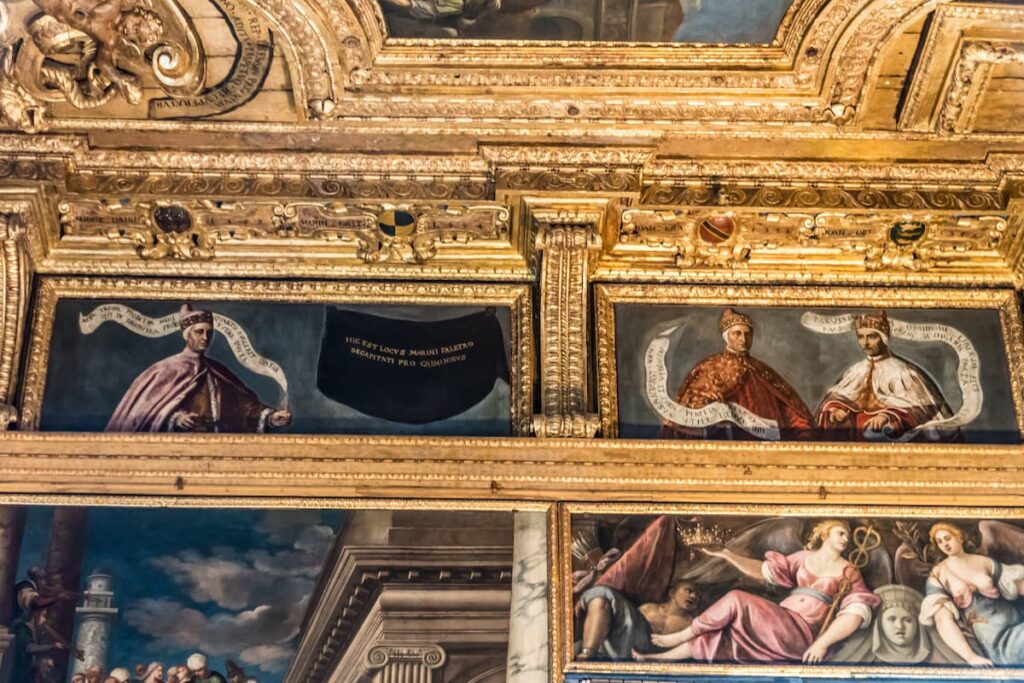
Under the ceiling of the Great Council Chamber, you will find a frieze by Tintoretto showing portraits of the first seventy-six doges of Venice, from 804 to 1556. In this representation, each doge holds a scroll on which the most important works carried out during his dogate are illustrated.
Among the portraits, you may notice one that stands out for its black drape: it is Marino Faliero, the doge who in 1355 undertook an attempted coup d’état and was sentenced to death by beheading.
The drape bears the inscription ‘HIC EST LOCUS MARINI FALETRO DECAPITATI PRO CRIMINUS’ (This is the place where Marino Faliero was beheaded for his crimes).
This part of the frieze pays homage to an obscure and significant moment in Venetian history, emphasising the importance of remembering even the less glorious events as an integral part of Venice’s history. The presence of Marino Faliero among the doges depicted, with his black drape and inscription, offers a visual snapshot of an episode that deeply marked the city’s history.

Doge’s Palace Venice skip-the-line ticket: quick access
Buy online. Choose your preferred time. Visit Venice’s Doge’s Palace, Bridge of Sighs, prisons and more.
You can cancel for free up to the day before your visit.
There was a blind Doge
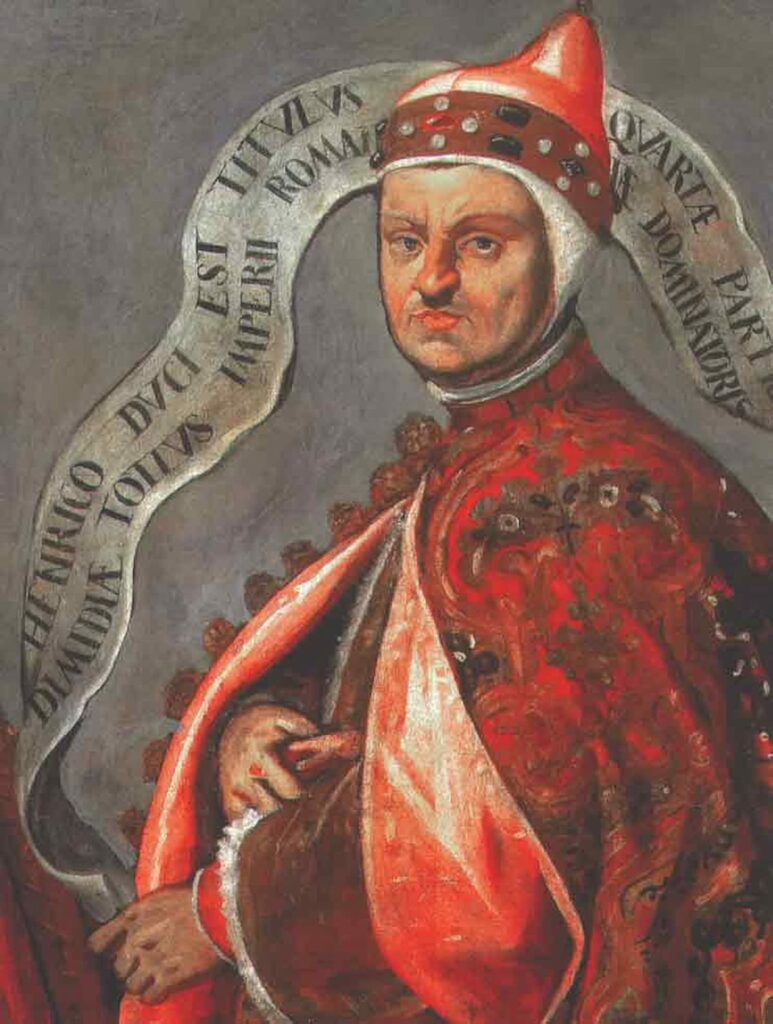
It is interesting to note how certain historical dynamics can be reflected in the modern politics of a city like Venice. Enrico Dandolo, one of the doges, who also had the particular trait of being blind, ruled during a period of significant change and crucial decisions.
Dandolo’s decision to expel foreigners who had resided in Venice for less than two years, but to allow those who had been in the city for longer to remain, may have been motivated by several factors.
This act may have been an attempt to stabilize the population, avoiding too rapid flows of immigrants that could have strained the city’s resources. Or it could have been a strategy to incentivize economic stability, as those who had resided in Venice for longer may have had a more positive economic impact on the community.
In the current context, Venetian policies aimed at managing the influx of tourists through measures such as the city entrance tax could stem from a similar logic. The government may be motivated to regulate tourism in order to balance the economic and social impact of visitors, seeking to ensure that the flow of tourists brings sustainable and lasting benefits to the city rather than only temporary or negative impacts.
History often offers interesting insights into the challenges and choices cities face in the present, and the case of Venice is an example of how historical decisions can still resonate in current debates and policies.
It was built to be a fortress (and not a palace)
The Doge’s Palace, initially not intended to be the residence of the Doges nor the seat of government, saw the light between the 10th and 11th centuries as a fortified center. This fortress had a main tower and other towers positioned at the corners, thus embodying the essence of Venetian Gothic architecture.
Later, in the 12th century, Doge Sebastiano Ziani transformed this fort into a refined palace. Over the years, subsequent rulers further extended the structure, shaping what we know today as the Doge’s Palace.
The different sections of the palace were used for various purposes: public offices, courtrooms, prisons, the Doge’s residence, stables, arsenal, and other facilities. Each part tells a unique story of life and government in this extraordinary venue, testifying to the complexity and importance of its function in the historical fabric of Venice.
Each high relief on columns and capitals tells a story
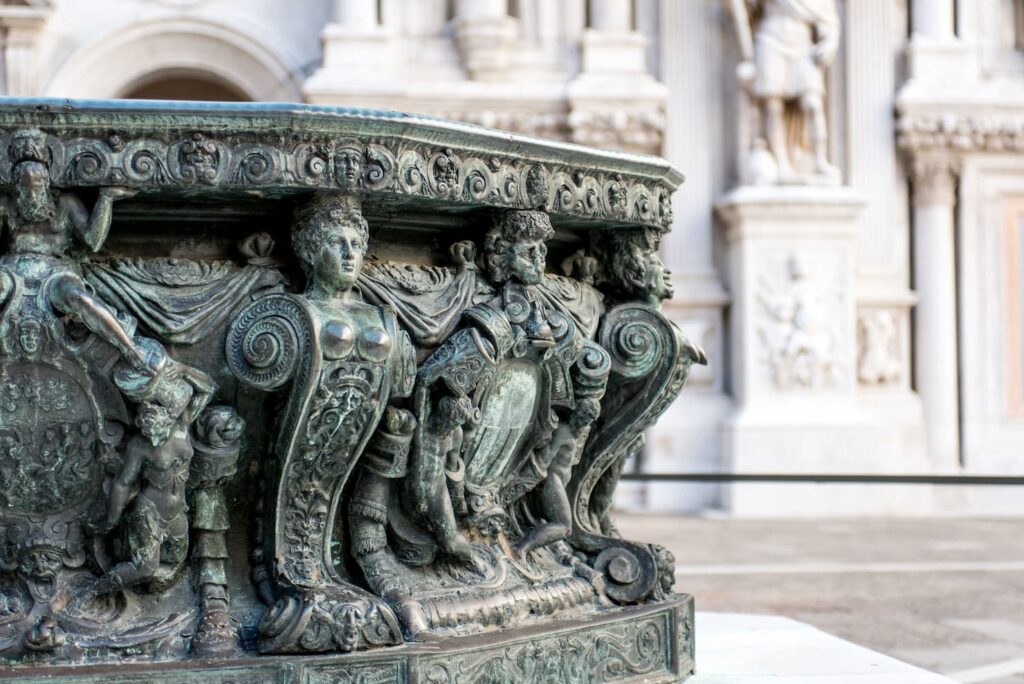
The Doge’s Palace is beautifully adorned with columns and capitals that told stories and allegories, designed to be fully appreciated by the people of the time. These sculpted reliefs could be considered a kind of visual epic poem, in which men, women, animals, plants, zodiac signs, myths, symbols, vices and virtues came to life through art.
At a time when literacy was the prerogative of the upper classes, the visual representation of stories proved to be the most effective way to communicate powerful ideas to a wide audience. The complex narratives carved into the details of columns and capitals became a kind of shared language through which people could access cultural sagas and emblems without having to read.
Some examples?
Without a doubt, the most famous among them is the depiction of ‘Drunken Noah’ by Filippo Calendario.
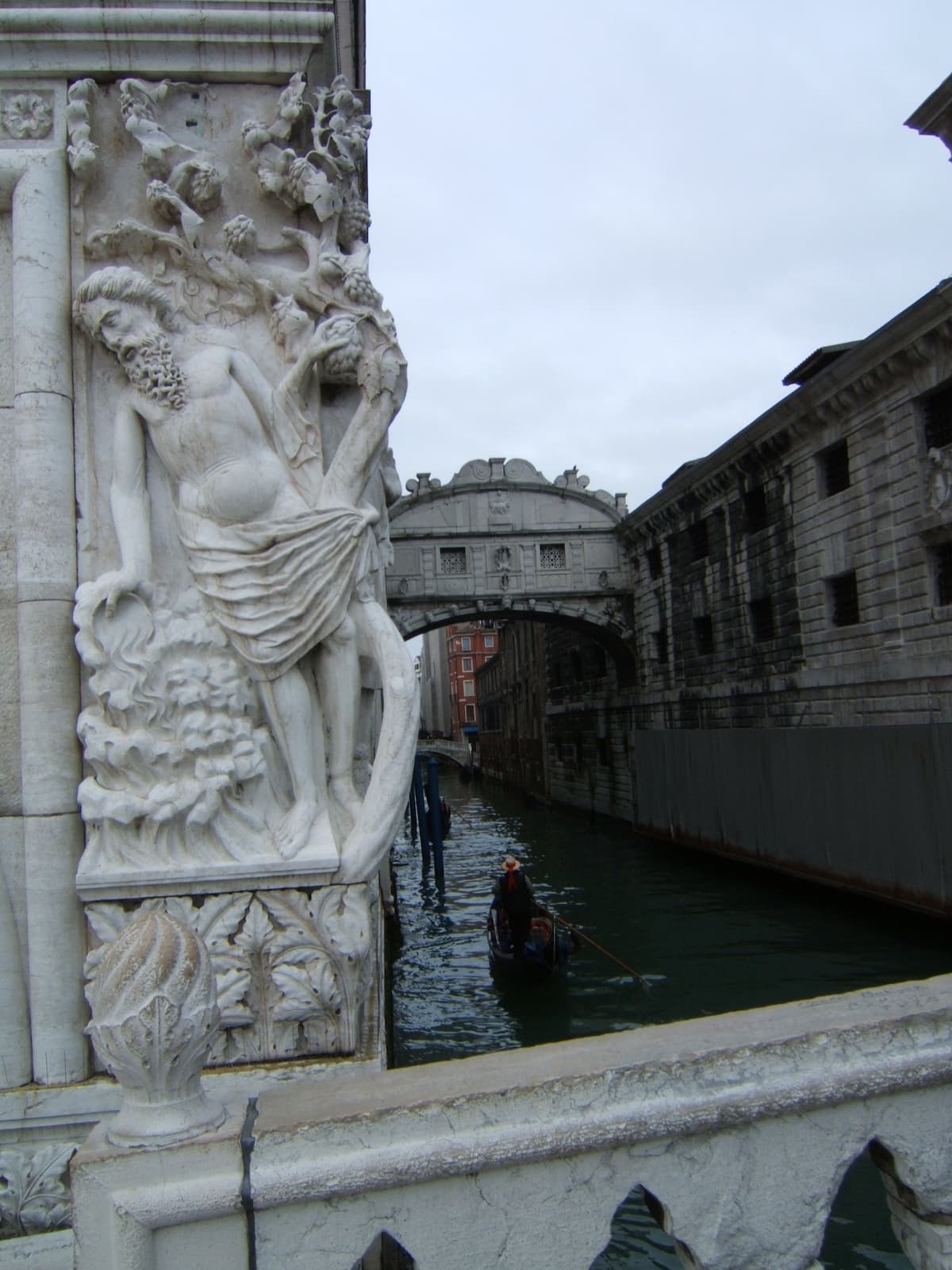
This relief depicts the moment of Noah’s drunkenness, a biblical episode that tells how one of Noah’s sons, upon seeing his father drunk, naked and disorderly, did not hesitate to divulge his unseemly state to his brothers.
This disrespect towards their father was later resolved by his other sons, who ran to cover him with a cloak, turning around to avoid seeing his nakedness. The underlying message is to remind those invested with the power of judgement of the importance of tempering severity with mercy.
Another very representative high relief depicts the ‘Judgement of Solomon’.
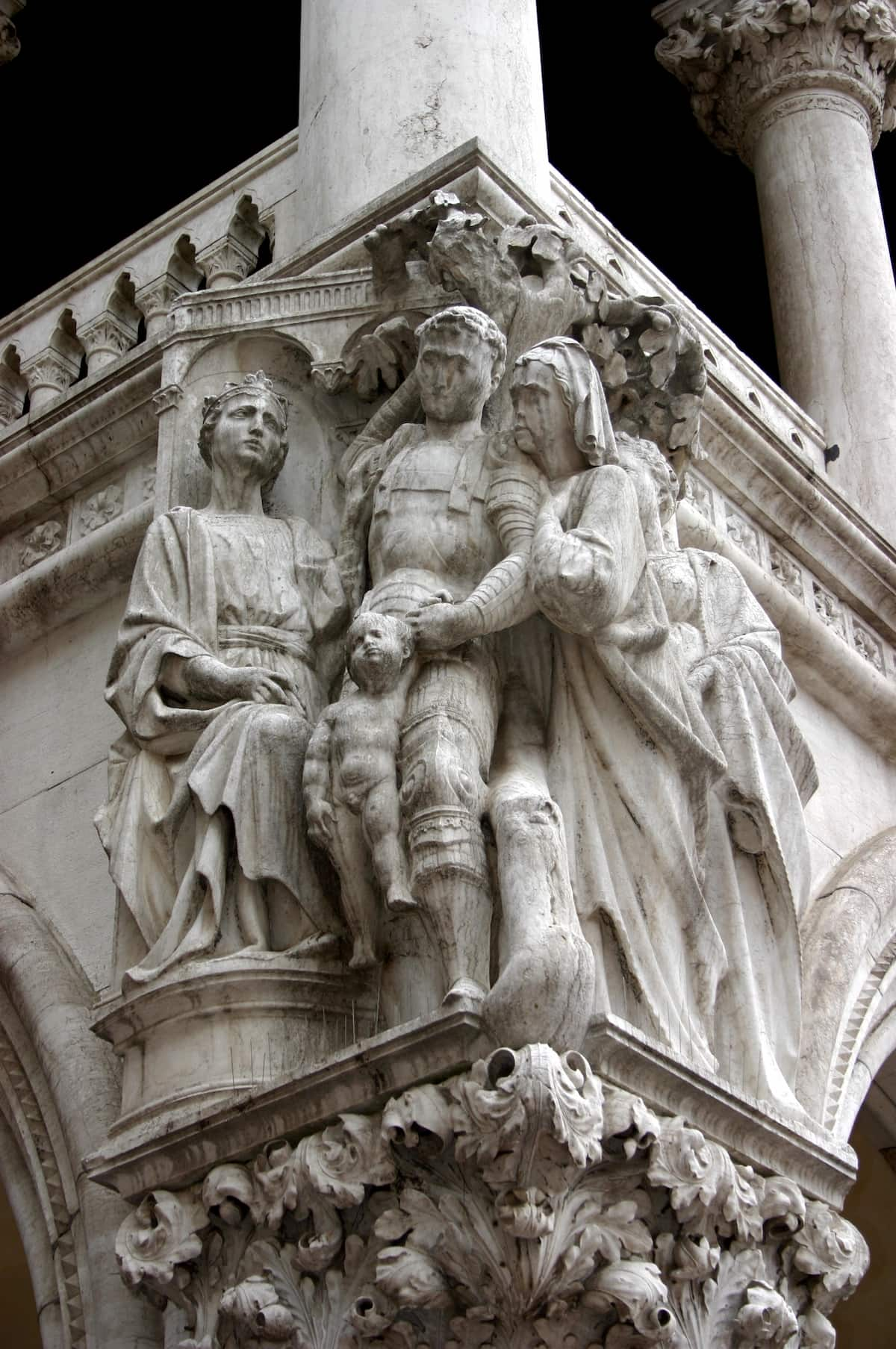
This biblical episode tells the story of two prostitutes who lived together, and each had a newborn child; one of the children died. The two women therefore appear before King Solomon, each claiming maternity of the surviving child.
The king, faced with this situation, decides to settle the matter by ordering them to bring a sword to divide the child into two parts. The child’s natural mother, stricken by the prospect of seeing her own child mutilated, begs the king to give the child to the other woman, revealing her true motherhood. The second woman, who had agreed to share the child, is thus revealed as the one who lacks authentic maternal attachment.
These high-reliefs tell stories of just and wise decisions, channeling concepts of fairness and discernment that have been embodied throughout history and are still relevant in today’s understanding of justice.
Casanova managed to escape from the prisons of the Doge’s Palace
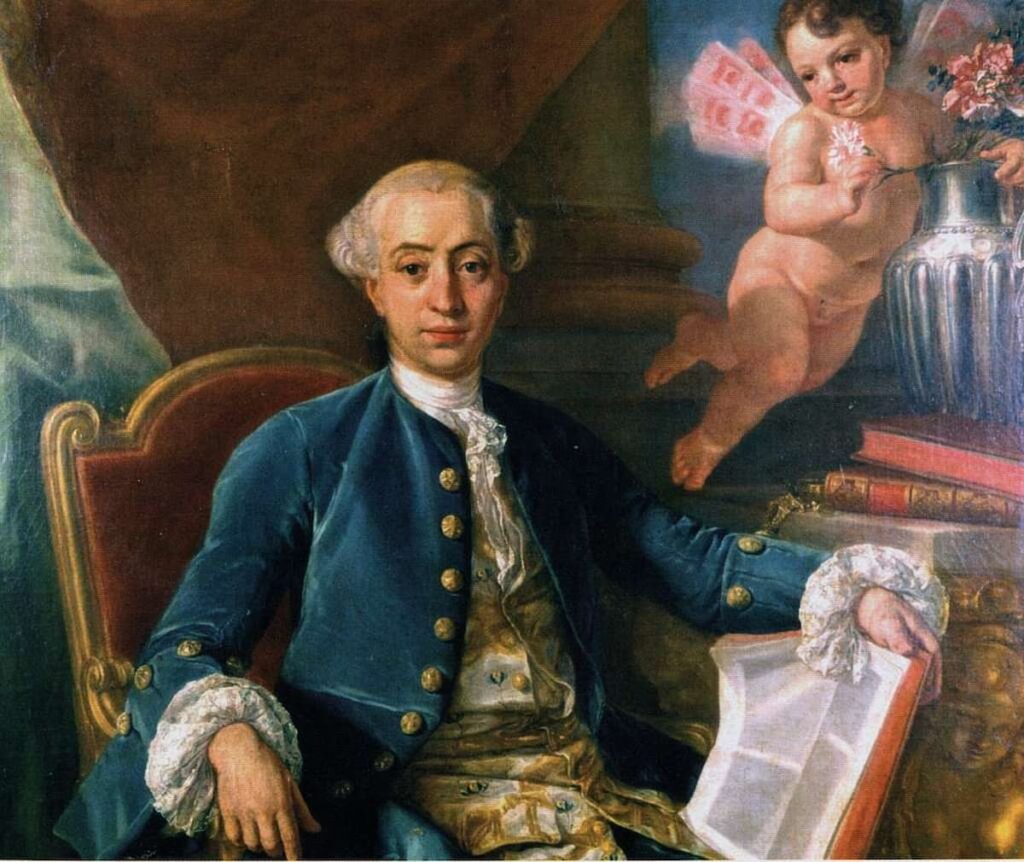
In July 1755, the famous adventurer and ladies’ man Giacomo Casanova, at the age of thirty, was arrested and imprisoned in the Piombi prison, located in the attic of the Doge’s Palace in Venice. Described as a tall, athletic man with a warm, deep voice, Casanova is adept at gambling and salons. He is an atheist, non-conformist and free thinker, as well as being a skilled adventurer with great resources.
The Piombi were small rooms completely paneled in wood. Casanova’s cell, above the Hall of the Three State Inquisitors, had a low ceiling that forced him to stand curved and had a large beam that obscured the skylight, preventing the use of lamps due to the fear of fire. The cells were extremely cold in winter and very hot in summer, with a lead roof contributing to these extreme conditions.
Casanova shared his cell with rats and fleas, and although the furniture was spartan, he was allowed to bring furniture from his home, including an armchair and books to pass the time. His cell was situated right above the Hall of the three state inquisitors, called the Red and the Black, who were responsible for judicial decisions. Casanova, whose goal was to escape from the beginning, starts digging a hole in the wooden floor to lower himself into the room of the inquisitors.
When his excavation is almost complete, he is moved to a more comfortable cell. Here he meets Father Balbi, another inmate, and together they plan their escape from the rooftops. Casanova hides an iron spike inside a Bible and, with an ingenious ruse, manages to get it delivered to Father Balbi through a jailer.
After eight days, they both manage to drill escape holes and, on the night of 1 November, escape. After some difficulties, Casanova manages to climb out of a window, being mistaken for a magistrate and helped to escape. He reaches Mestre and then Bolzano, narrating his daring escape from the Piombi of the Doge’s Palace in Venice in drawing rooms all over Europe for years to come.
The Doge’s Palace was reproduced in the video game Assassin’s Creed II
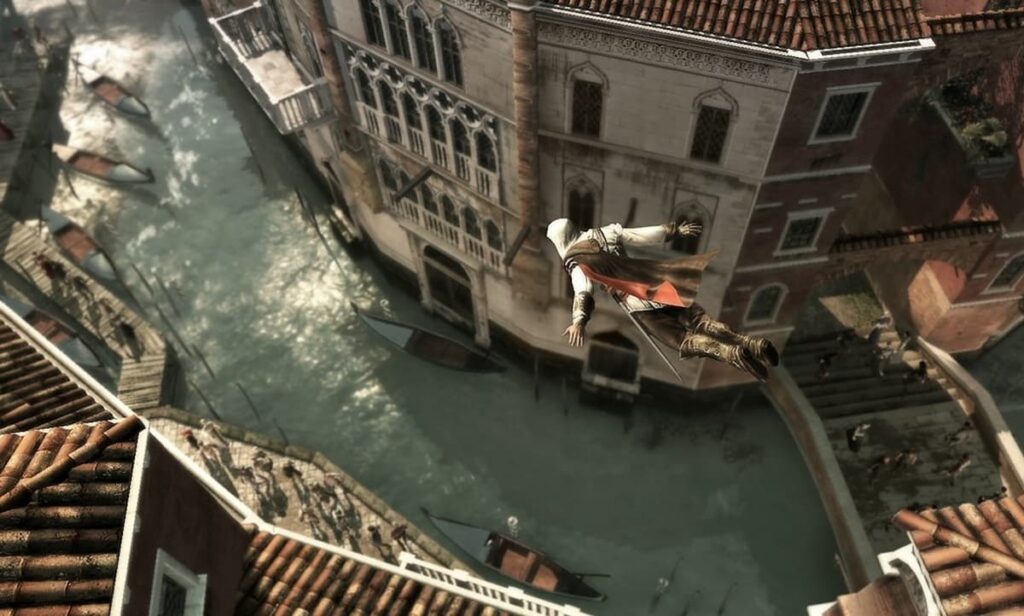
The video game Assassin’s Creed II is set in Italy at the time of the Renaissance, in the cities of Venice, Rome, Florence and other smaller towns in Tuscany.
One of the most important locations is the Doge’s Palace, which the protagonist must gain access to in sequence number 8.
To do so, he will have to scale the facade of the building, walk on pillars, jump and climb over large windows.
Inside the video game, it is also possible to enter the room where Doge Mocenigo played chess with Charles (it is still possible to see the chessboard inside the room).
Conclusions
Here we are at the end of this article on curiosities about the Doge’s Palace in Venice.
If you would like to admire the prisons from which Casanova escaped, the Bridge of Lovers, the Doge’s flats, and the façade from which the protagonist of the video game Assassin’s Creed climbs, you can book a guided tour of the Palace by clicking here.
If you have any doubts, questions, or other curiosities of the Doge’s Palace to suggest, leave a comment below and I will be happy to answer you.
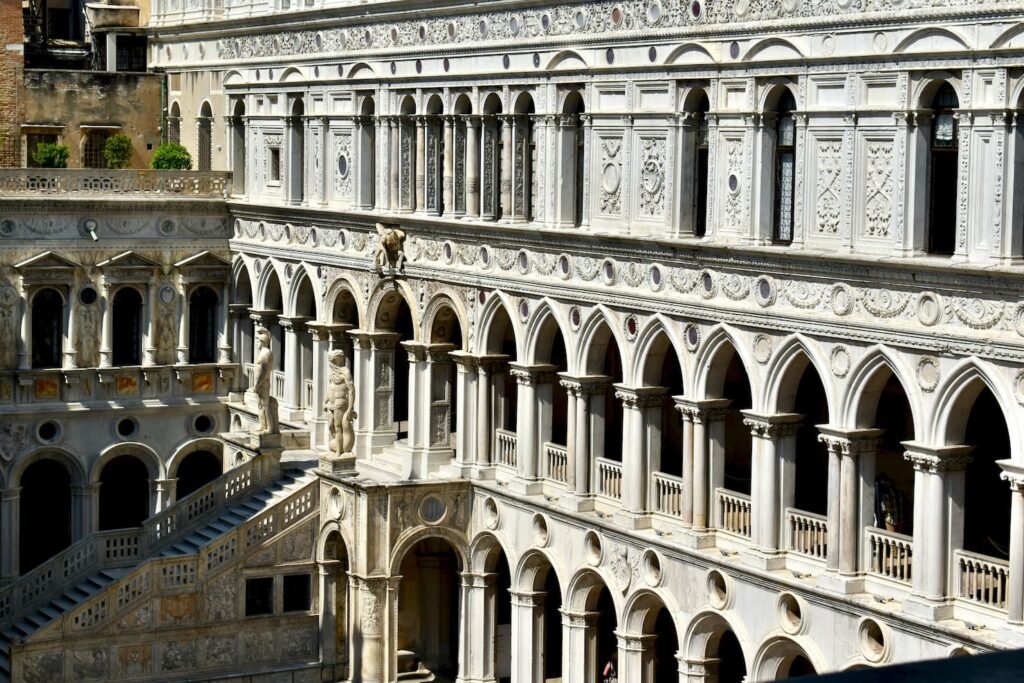
Doge’s Palace Venice skip-the-line ticket: quick access
Buy online. Choose your preferred time. Visit Venice’s Doge’s Palace, Bridge of Sighs, prisons and more.
You can cancel for free up to the day before your visit.
Photo credits:
- Giacomo Casanova: Photo by Kos via Wikimedia
- Enrico Dandolo: Photo byi Nobility of Europe via Wikimedia
- Marino Faliero e il drappo nero: Photo by Falcodigiada via Wikimedia
- Noè Ubriaco: Photo by alessandro su Flickr
- Giudizio di Salomone: Photo by Giovanni Dall’Orto via Wikimedia
- Incendio Palazzo Ducale: Photo by Sailko via Wikimedia
- Assassin’s Creed: Photo by cea + via Flickr
